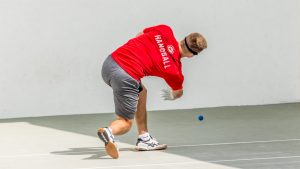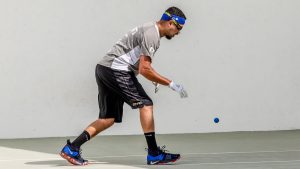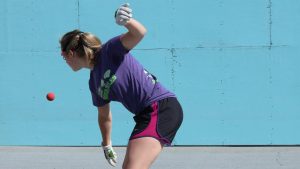WPH Press, 11/17/20
 Many handball players have transitioned from 4-Wall to outdoor handball during this pandemic, where players are able to socially distance and avoid indoor hotspots. The serve in 3-Wall small ball handball is the player’s greatest weapon, as a variety of serves can yield aces or weak returns.
Many handball players have transitioned from 4-Wall to outdoor handball during this pandemic, where players are able to socially distance and avoid indoor hotspots. The serve in 3-Wall small ball handball is the player’s greatest weapon, as a variety of serves can yield aces or weak returns.
The 4-Wall power serve must be struck low and just barely cross the short line to be effective, as an over hit serve in 4-Wall will leave a back wall setup. A deep serve in 3-Wall is often the most potent serve, as the deep power drive forces the returner to hit from behind the line, often off-balance and with the off-hand.
“I believe the serve in 3-wall often ends up being the most important element of the game, particularly when you have otherwise evenly matched opponents,” stated 20+ time national champion and the WPH Wrap Around’s Dr. Dan Zimet.. “A devastating serve works for you in numerous ways, including accruing easy points through unreturned serves or easy put-aways, demoralizing your opponent, and conserving energy. The serve also sets the tone for the ensuing rally and says something critical about a player. Players whose serve does little more than put the ball in play are likely to be less aggressive during a rally as well, and often rely on retrieving, wearing an opponent down, and scoring on opponent hand errors to win points. Players whose serve has distinct purpose are likely to be more offense minded, and focused on getting ahead in a point quickly and continuing to press that advantage. For this reason, the goal of a serve is not to put the ball in play – it is to get on offense.”
 “Serving on a 3-Wall court was probably my favorite thing to do in handball,” stated multiple-time pro 3-Wall national champion and hall of famer John Bike, Jr. “Returning serve on a 3-Wall court was one of my least favorite.”
“Serving on a 3-Wall court was probably my favorite thing to do in handball,” stated multiple-time pro 3-Wall national champion and hall of famer John Bike, Jr. “Returning serve on a 3-Wall court was one of my least favorite.”
“A well placed power serve is the most devastating shot in 3-Wall,” stated 2019 3-Wall nationals pro finalist Abraham Montijo. “It can lead you directly to a point (ace serve) or allow you to dictate the remainder of the rally by controlling your opponent’s position on the court.”
The 3-Wall power serve provides a number of opportunities for aces. Let’s examine each opportunity:
- Short/crack or down the wall just past the service line on the left
- Short/crack or down the wall just past the service line on the right
- Deep drive to the left
- Deep drive to the right
- Power hop down the middle
 These five 3-Wall power serves also provide variations, as the server can hit “out the door” angles with hop to the left or right. In pro matches crunched, the 3-Wall power serve has yielded an average of 2.4 times as many aces/unreturned serves as the 4-Wall power serve, no surprise given the various options the 3-Wall power serve provides.
These five 3-Wall power serves also provide variations, as the server can hit “out the door” angles with hop to the left or right. In pro matches crunched, the 3-Wall power serve has yielded an average of 2.4 times as many aces/unreturned serves as the 4-Wall power serve, no surprise given the various options the 3-Wall power serve provides.
“I used the deep natural (hop) to the left most often,” stated The Bicrowave. “Off the same motion I could hit it slightly lower and higher with more hook. With a small adjustment I could sneak one over the short line to the right or pull one across my body to the deep right corner. Everything worked off the one to the deep left because even slight misses over there were still difficult to return with any authority.”
“The key to a great power serve is control and consistency,” stated Montijo. “Hitting the ball hard is no good if you can’t place it properly. Being able to hit the ball 6-12 inches from the back line 9/10 times will earn you a lot of points. Once you can master hitting the ball a few inches from the long line, you can start developing the hook serves that bounce out of the court or into your opponent. I believe the ability to do this changes your status from a great power server to an elite server.”
 Head out to your 3-Wall courts and develop your 3-Wall power serve today!
Head out to your 3-Wall courts and develop your 3-Wall power serve today!
WPH 3-Wall Power Serve Tutorial HERE
David Fink
WPH Senior Writer









